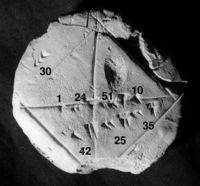نظام العد الستيني
| أنظمة الأرقام حسب الثقافة | |
|---|---|
| الأرقام الهندية العربية | |
| العربية المغربية العربية المشرقية الخمير |
العائلة الهندية البراهمية التايلندية |
| أرقام شرق آسيا | |
| الصينية سوژو عصي العد |
اليابانية الكورية |
| الأرقام الأبجدية | |
| أبجد الأرمنية السيريلية جعيز |
العبرية اليونانية (Ionian) أريابهاتا |
| أنظمة أخرى | |
| Attic البابلية المصرية الإتروسكية |
المايا الرومانية Urnfield |
| قائمة مواضيع نظم الأرقام | |
| Positional systems by base | |
| عشري (10) | |
| 2, 4, 8, 16, 32, 64 | |
| 1, 3, 9, 12, 20, 24, 30, 36, 60, more… | |
النظام الستيني Sexagesimal هو نظام عد قاعدته ستينية. اخترع السومريون هذا النظام في الألفية الثالثة ق م, ونقلها عنهم البابليون, وهو ما زال مستخدمًا في قياس الزمن والزوايا الهندسية ونظام الإحداثيات الجغرافية.
الرقم 60 يمكن تحليله إلى 12 عدد, وهي { 1, 2, 3, 4, 5, 6, 10, 12, 15, 20, 30, 60 } من بينها 2، 3، 5 وهي أعداد أولية.
الرياضيات البابلية
 مقالة مفصلة: الرياضيات البابلية
مقالة مفصلة: الرياضيات البابلية
الكسور
| الكسر: | 1/2 | 1/3 | 1/4 | 1/5 | 1/6 | 1/8 | 1/9 | 1/10 |
|---|---|---|---|---|---|---|---|---|
| الستيني: | 30 | 20 | 15 | 12 | 10 | 7,30 | 6,40 | 6 |
| الكسر: | 1/12 | 1/15 | 1/16 | 1/18 | 1/20 | 1/24 | 1/25 | 1/27 |
| الستيني: | 5 | 4 | 3,45 | 3,20 | 3 | 2,30 | 2,24 | 2,13,20 |
| الكسر: | 1/30 | 1/32 | 1/36 | 1/40 | 1/45 | 1/48 | 1/50 | 1/54 |
| الستيني: | 2 | 1,52,30 | 1,40 | 1,30 | 1,20 | 1,15 | 1,12 | 1,6,40 |
However numbers that are not regular form more complicated repeating fractions. فعلى سبيل المثال:
- 1/7 = 0;8,34,17,8,34,17 ... (with the sequence of sexagesimal digits 8,34,17 repeating infinitely many times) = 0;8,34,17
- 1/11 = 0;5,27,16,21,49
- 1/13 = 0;4,36,55,23
- 1/14 = 0;4,17,8,34
- 1/17 = 0;3,31,45,52,56,28,14,7
- 1/19 = 0;3,9,28,25,15,47,22,6,18,56,50,31,34,44,12,37,53,41
The fact in arithmetic that the two numbers that are adjacent to sixty, namely 59 and 61, are both prime numbers implies that simple repeating fractions that repeat with a period of one or two sexagesimal digits can only have 59 or 61 as their denominators (1/59 = 0;1; 1/61 = 0;0,59), and that other non-regular primes have fractions that repeat with a longer period.
أمثلة
The square root of 2, the length of the diagonal of a unit square, was approximated by the Babylonians of the Old Babylonian Period (1900 BC – 1650 BC) as
Because is an irrational number, it cannot be expressed exactly in sexagesimal (or indeed any integer-base system), but its sexagesimal expansion does begin 1;24,51,10,7,46,6,4,44 ...
The length of the tropical year in Neo-Babylonian astronomy (see Hipparchus), 365.24579... days, can be expressed in sexagesimal as 6,5;14,44,51 (6×60 + 5 + 14/60 + 44/602 + 51/603) days. The average length of a year in the Gregorian calendar is exactly 6,5;14,33 in the same notation because the values 14 and 33 were the first two values for the tropical year from the Alfonsine tables, which were in sexagesimal notation.
The value of π as used by the Greek mathematician and scientist Claudius Ptolemaeus (Ptolemy) was 3;8,30 = 3 + 8/60 + 30/602 = 377/120 ≈ 3.141666....[2] Jamshīd al-Kāshī, a 15th-century Persian mathematician, calculated π in sexagesimal numbers to an accuracy of nine sexagesimal digits; his value for 2π was 6;16,59,28,1,34,51,46,14,50.[3][4]
انظر أيضاً
الهامش
- ^ YBC 7289 clay tablet
- ^ Toomer, G. J., ed. (1984), Ptolemy's Almagest, New York: Springer Verlag, p. 302, ISBN 0-387-91220-7
- ^ Youschkevitch, Adolf P., "Al-Kashi", in Rosenfeld, Boris A., Dictionary of Scientific Biography, p. 256.
- ^ Aaboe (1964), p. 125
للاستزادة
- Ifrah, Georges (1999), The Universal History of Numbers: From Prehistory to the Invention of the Computer, Wiley, ISBN 0-471-37568-3.
- Nissen, Hans J.; Damerow, P.; Englund, R. (1993), Archaic Bookkeeping, University of Chicago Press, ISBN 0-226-58659-6
وصلات خارجية
- "Facts on the Calculation of Degrees and Minutes" هو كتاب بالعربية كتبه سبط المارديني، بدر الدين محمد بن محمد (و. 1423). هذا الكتاب يطرح معالجة مفصلة جداً لرياضيات العد الستيني ويضم ما يبدو أنه أول ذكر لدورية الكسور الستينية.



